Nissan Maxima Service and Repair Manual: Front disc brake
Exploded View of Brake Pads
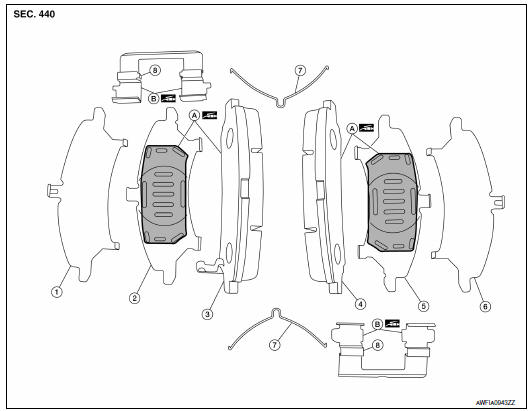
- Inner shim cover
- Inner shim
- Inner pad
- Outer pad
- Outer shim
- Outer shim cover
- Anti-rattle clips
- Pad retainers
- Molykote AS-880N grease
- Molykote 7439 grease
Removal and Installation of Brake Pads
WARNING: Clean dust on caliper and brake pad with a vacuum dust collector to minimize the hazard of air borne particles or other materials.
CAUTION:
- While removing brake pads, do not depress brake pedal because piston will pop out.
- It is not necessary to remove bolts on torque member and brake hose except for disassembly or replacement of caliper assembly. For brake pad removal, hang cylinder body with a wire so as not to stretch brake hose.
- Do not damage piston boot.
- If any shim is subject to serious corrosion, replace it with a new one.
- Always replace shim and shim cover as a set when replacing brake pads.
- Keep rotor and pads free from grease and brake fluid.
- Burnish the brake pads and disc rotor contacting surfaces, after refinishing or replacing rotors, after replacing pads, or if a soft pedal occurs at very low mileage. Refer to BR-31, "Brake Burnishing Procedure".
REMOVAL
- Remove front wheel and tire using power tool. Refer to WT-60, "Adjustment".
- Partially drain brake fluid from master cylinder.
- Remove the upper and lower sliding pin bolts.
NOTE: Note the sliding pin orientation during removal. The lower sliding pin contains a bushing. - Remove the brake caliper from the torque member. Leaving the brake hose attached, reposition the brake caliper aside with wire.
- Remove anti-rattle clips, pads, shims, and shim covers from torque member.
INSTALLATION
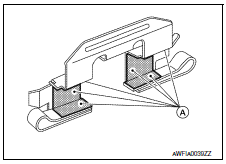
- Apply Molykote AS-880N grease or equivalent between the inner and outer shims and the back of the brake pads.
- Install the inner and outer shims and shim covers to the inner pad
and outer pad.
CAUTION: Do not get grease on the inner and outer pad friction surfaces. - Apply Molykote 7439 grease (A) or equivalent to the pad retainer and attach the pad retainer to the torque member.
- Install the assembled inner and outer shims, shim covers, pads
and anti-rattle clips to the torque member.
CAUTION: Do not get grease on the inner and outer pad or rotor friction surfaces. - Press piston into cylinder body using suitable tool, then install
the cylinder body on the torque member.
CAUTION: When replacing pads with new set, check the brake fluid level in the reservoir tank because brake fluid returns to the master cylinder reservoir tank when pressing in the piston. - Install the upper and lower sliding pin bolts (2) and tighten it to the specified torque.
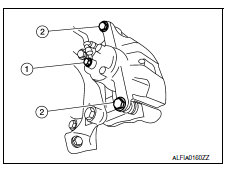
- Union bolt (1)
- Check front disc brakes for drag.
- Install the front wheel and tire. Refer to WT-60, "Adjustment".
- Check brake fluid level and refill as necessary. Refer to BR-16, "Inspection".
Brake Burnishing Procedure
Burnish contact surfaces between disc rotors and pads according to following procedure after refinishing or replacing rotors, after replacing pads, or if a soft pedal occurs at very low mileage.
CAUTION:
- Be careful of vehicle speed because the brake does not operate easily until pad and disc rotor are securely fitted.
- Only perform this procedure under safe road and traffic conditions. Use extreme caution.
- Drive vehicle on straight, flat road.
- Depress brake pedal with the power to stop vehicle within 3 to 5 seconds until the vehicle stops.
- Drive without depressing brake for a few minutes to cool the brake.
- Repeat steps 1 to 3 until pad and disc rotor are securely fitted.
Exploded View of Brake Caliper
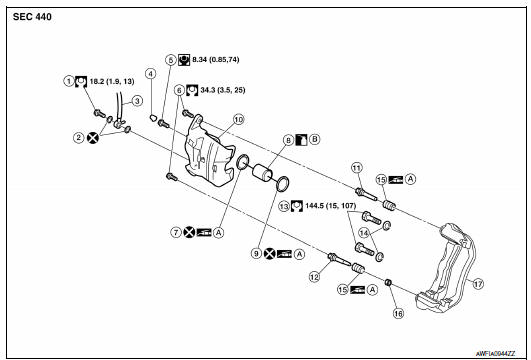
- Union bolt
- Copper sealing washer
- Brake hose
- Cap
- Bleed valve
- Sliding pin bolt
- Piston seal
- Piston
- Piston boot
- Cylinder body
- Upper sliding pin
- Lower sliding pin bolt
- Torque member bolt
- Washer
- Sliding pin boot
- Bushing
- Torque member
- Rubber grease
- Brake fluid
Removal and Installation of Brake Caliper and Rotor
WARNING: Clean dust on caliper and brake pad with a vacuum dust collector to minimize the hazard of air borne particles or other materials.
CAUTION:
- When removing and installing the cylinder body, do not depress the brake pedal because the piston will pop out.
- Do not damage the piston boot.
- Keep the brake rotor free from grease and brake fluid.
- Refill the brake reservoir with new brake fluid only.
- Do not reuse the drained brake fluid.
NOTE: When removing components such as hoses, tubes/lines, etc., cap or plug openings to prevent fluid from spilling.
REMOVAL
- Remove front wheel and tire using power tool. Refer to WT-60, "Adjustment".
- Secure the disc rotor using a wheel nut.
- Remove the reservoir cap.
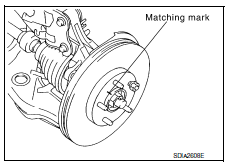
- Remove the union bolt (1) and disconnect the brake hose from the caliper
assembly. Discard the copper
sealing washers.
CAUTION: Do not reuse copper sealing washers. - Remove the upper and lower sliding pin bolts.
NOTE: Note the sliding pin orientation during removal. The lower sliding pin contains a bushing. - Remove the brake caliper.
- Remove the torque member bolts (2), and the torque member.
CAUTION: Do not drop the brake pads. - Remove the disc rotor. If reusing the disc rotor, apply a matching
mark as shown for installation.
CAUTION: Put matching marks on wheel hub assembly and disc rotor, if reusing the disc rotor.
INSTALLATION
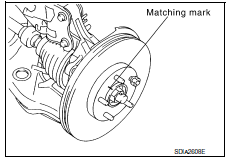
- Install the disc rotor. If reusing the disc rotor, align the matching mark on the disc rotor and wheel hub assembly for installation as shown.
CAUTION: Align the matching marks on wheel hub assembly and disc rotor, if reusing the disc rotor.
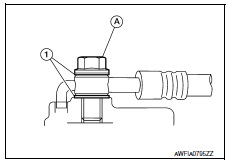
- Install the brake caliper assembly, and tighten the torque member bolts
to the specified torque.
CAUTION: Do not allow oil or any moisture on all contact surfaces between steering knuckle and caliper assembly, bolts, and washer. - Install the brake hose with two new copper sealing washers (1),
using the L-shaped pin for alignment as shown, then tighten the
union bolt (A) to the specified torque.
CAUTION: Do not reuse copper sealing washers. - Refill the brake hydraulic system with new brake fluid and bleed air. Refer to BR-16, "Bleeding Brake System".
- Check the front disc brakes for drag.
- Install the reservoir cap.
- Install the front wheel and tire. Refer to WT-60, "Adjustment".
 Vacuum lines
Vacuum lines
Exploded View
Clamp
Installation arrow
Vacuum hose
Vacuum pipe
Clip
To intake manifold
To brake booster
Front
Removal and Installation
REMOVAL
Disconnect the vacuum ...
 Rear disc brake
Rear disc brake
Exploded View of Brake Pads
Inner shim cover
Inner shim
Inner pad
Pad retainer
Outer pad
Outer shim
Outer shim cover
Molykote AS-880N grease
Molykote 7439 grease
Remov ...
Other materials:
Automatic air conditioner system
System Diagram
CONTROL SYSTEM
The control system consists of input sensors, switches, the A/C auto amp.
(microcomputer) and outputs. The
relationship of these components is as shown in the figure below:
System Description
CONTROL OPERATION
Display
The operation status of the HVAC system ...
Precaution
Precaution for Supplemental Restraint System (SRS) "AIR BAG" and
"SEAT BELT PRE-TENSIONER"
The Supplemental Restraint System such as "AIR BAG" and "SEAT BELT
PRE-TENSIONER", used along with a front seat belt, helps to reduce the risk
or severity of injury to the driver and front passenger for ...
Blower motor control system
System Diagram
System Description
Fan speed is automatically controlled by the temperature setting, ambient
temperature, in-vehicle temperature,
intake temperature, amount of sunload and air mix door position.
By pressing the AUTO switch, the blower motor starts to gradually increase
a ...
Nissan Maxima Owners Manual
- Illustrated table of contents
- Safety-Seats, seat belts and supplemental restraint system
- Instruments and controls
- Pre-driving checks and adjustments
- Monitor, climate, audio, phone and voice recognition systems
- Starting and driving
- In case of emergency
- Appearance and care
- Do-it-yourself
- Maintenance and schedules
- Technical and consumer information
Nissan Maxima Service and Repair Manual
0.007
